 |
 |
 |
| |
Intermittent Oral PrEP with Truvada Prevents Vaginal SHIV Transmission in Macaques
|
| |
| |
CROI 2012
Reported by Jules Levin
J. Radzio, W. Aung, S. Ruone, A. Martin, C-P Pau, E. Sweeney, J. Mitchell, A. Bachman, W. Heneine, J.G. Garc’a-Lerma Division of HIV/AIDS Prevention, Centers for Disease Control and Prevention, Atlanta, GA, US
SUMMARY
·As in humans, FTC and FTC-TP concentrations were high and similar in both vaginal and rectal tissues while the concentrations of TFV and TFV-DP were substantially lower in vaginal tissues. These findings validate the use of pigtails macaques to explore efficacy of Truvada against vaginal transmission
·A simple Truvada regiment with only 2 doses given 24h before and 2h after exposure resulted in full protection from infection. The high prophylactic efficacy seen with intermittent Truvada suggests that effective PrEP may not require daily drug dosing, and opens the possibility for intermittent PrEP regimens for preventing sexual HIV transmission in humans.
ABSTRACT
Intermittent Oral PrEP with Truvada Prevents Vaginal SHIV Transmission in Macaques
Jessica Radzio, W Aung, S Ruone, A Martin, C-P Pau, E Sweeney, J Mitchell, S Bachman, W Heneine, and G Garcia-Lerma
CDC, Atlanta, GA, US
Background: Daily pre-exposure prophylaxis (PrEP) with Truvada (a combination of emtricitabine [FTC] and tenofovir [TFV] disoproxil fumarate [TDF]) is a novel HIV prevention strategy recently found to prevent HIV transmission among men who have sex with men and heterosexual couples. We previously showed that intermittent PrEP regimens containing only 2 doses of Truvada administered before and after virus exposure were sufficient to prevent rectal SHIV transmission in macaques. Here, we assessed in macaques drug exposures in vaginal tissues after oral Truvada, and evaluated the efficacy of an intermittent Truvada regimen against vaginal SHIV transmission.
Methods: The pharmacokinetic profile of FTC and TDF in vaginal secretions was evaluated at first dose in 10 pigtail macaques and was compared with that seen in blood and rectal secretions. The ratio between AUC0-48h in vaginal and rectal secretions was used to measure relative drug exposure in vaginal and rectal tissues. Efficacy of oral Truvada in preventing vaginal transmission was evaluated in pigtail macaques with normal menstrual cycles using a repeat-exposure SHIV transmission model consisting of weekly exposures to low doses of SHIV162p3. We gave 6 macaques orally a human-equivalent dose of Truvada (20 mg/kg FTC and 22 mg/kg TDF) 24 hours before virus exposure and a second dose 2 hours thereafter; and 6 additional control macaques, placebo. Infection was monitored by serology and PCR amplification.
Results: As in humans, FTC concentrations were similar in vaginal and rectal tissues (AUC0-48h = 112,267 ng · h/mL and 93,328 ng · h/mL, respectively). TFV exposure was lower (9.7-fold) in vaginal than in rectal tissues (AUC0-48h = 17,060 ng · h/mL and 165,304 ng · h/mL, respectively), also consistent with humans. Despite the low vaginal TFV exposure, all 6 treated macaques were protected from infection after 16 exposures or 4 complete menstrual cycles. In contrast, all 6 control animals were infected.
Conclusions: As in humans, TFV exposure in vaginal tissues from macaques was lower than in rectal tissue while FTC levels were similar in both compartments. Despite low vaginal TFV levels, intermittent PrEP with Truvada protected macaques against repeated vaginal SHIV exposures. Our results in macaques suggest that effective PrEP with Truvada against vaginal transmission may not require daily dosing, and open the possibility for intermittent PrEP regimens for preventing vaginal HIV transmission in humans.
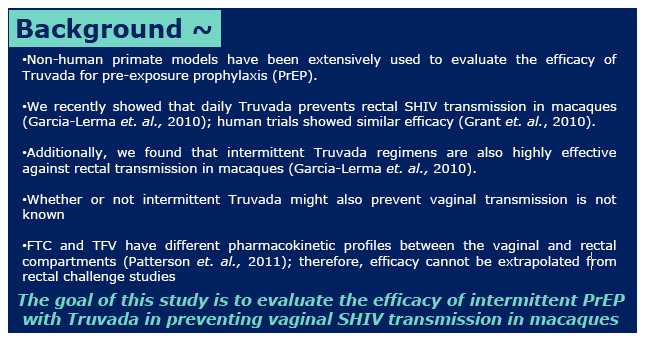
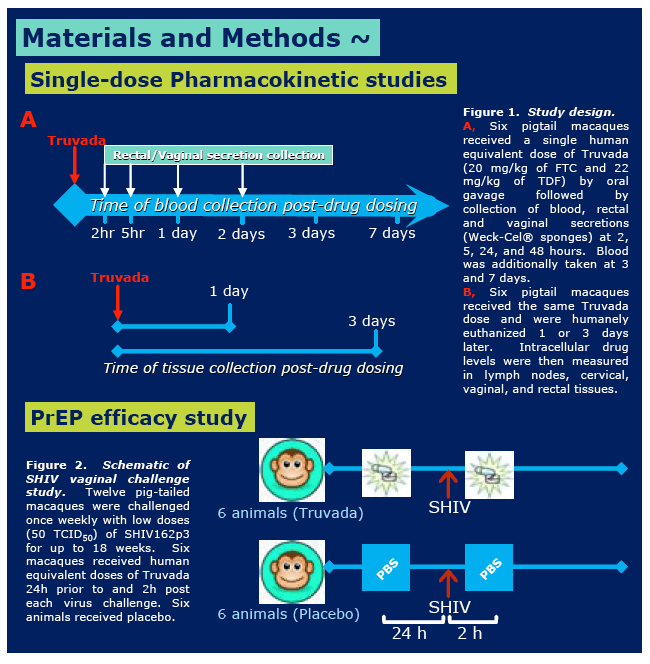
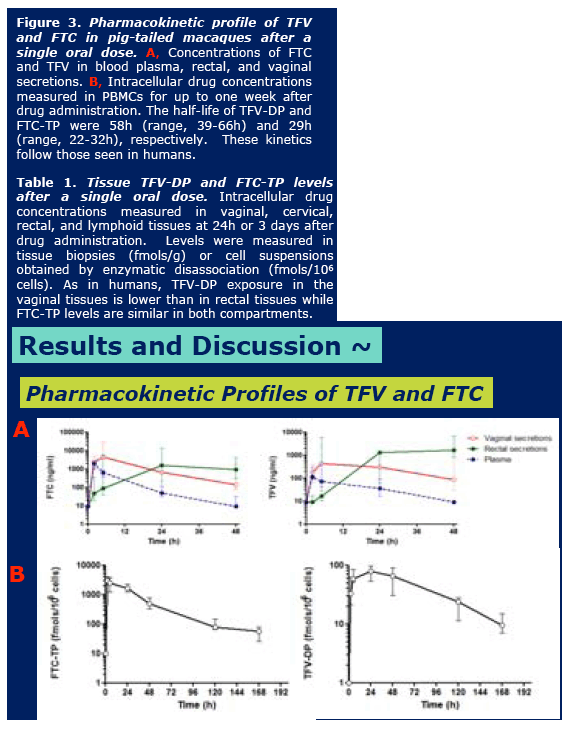

Efficacy of Truvada in Preventing Vaginal SHIV Transmission
Table 2. Baseline characteristics of macaques in the Truvada and placebo arms. Animals were equally distributed based on age, weight, peak progesterone levels, and detectable menses. Parameters did not vary significantly between the two groups (p > 0.5, for each comparison, Mann-Whitney two-tailed t-test)
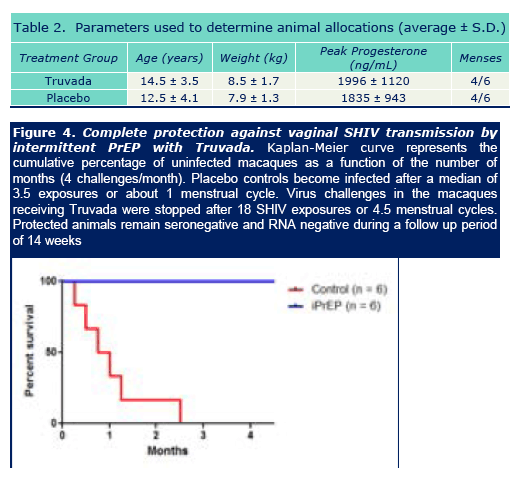
Figure 5. Progesterone levels in macaques during vaginal challenges. Progesterone levels were determine using a commercially available progesterone EIA Kit (Cayman Chemical). All animals had normal lunar menstrual cycles. A, Progesterone levels in controls macaques. The red arrow indicates first RNA detection; 4/6 animals were infected during the luteal phase assuming a 7-14 days eclipse phase. B, Treated macaques were protected for an average of 4 menstrual cycles
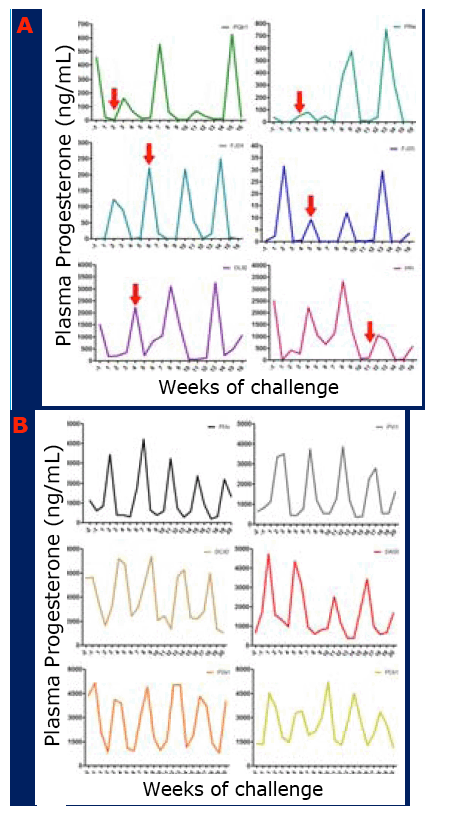
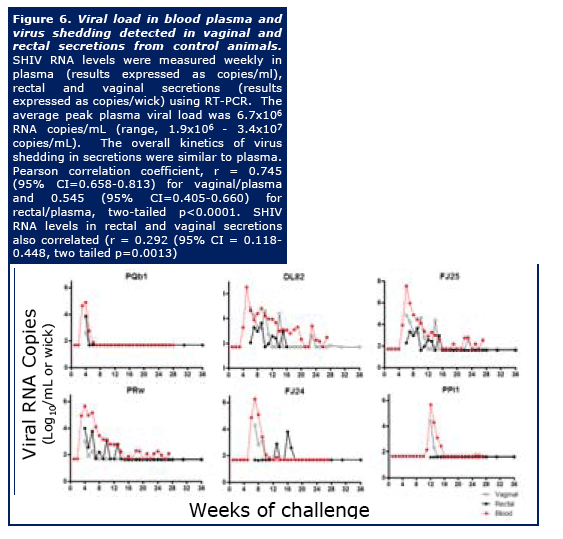
|
| |
|
 |
 |
|
|